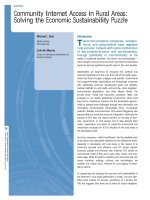School Dropout in Rural Vietnam: Does Gender Matter
Bạn đang xem bản rút gọn của tài liệu. Xem và tải ngay bản đầy đủ của tài liệu tại đây (337.49 KB, 13 trang )
School Dropout in Rural
Vietnam: Does Gender Matter?
Jianye Liu
Population Study Center
Sociology Department of UWO
Why this topic?
Education is not only a human right, but is also
crucial to national, familial, and individual
development.
It is a central concern in every developing country.
While the enrollment of girls has increased in past
decades, girls continue to be less likely to
complete their schooling.
Why Vietnam?
Cultural practices
•
The Chinese Occupation of Vietnam:
-Confucianism: women have lower status than men both
in family and society
-Patriarchal, Patrilineal and Patrilocal society.
•
The French Occupation and then socialism cancelled out
many of the values of Confucianism.
•
Socialist reforms (market-oriented) since 1986
resumed many of the values of Confucianism.
- the kinship system
- son preference
Economic situation:
1.
Vietnam is a poor country: a typical pyramid structure of
education system (no enough space for children in
schoool).
2.
Recent economic reforms:
school system is mainly funded by local governments
and the family.
3.
The household average expenditure on schooling has
more than doubled in the 1990s.
4.
The family is the basic productive unit: More child labor
is needed both inside household and in the farm work.
5.
Results in a relatively high “school dropout rate”.
Theoretical framework
Data and Methodology
Data
Vietnam Living Standard Surveys (VLSS) conducted
in 1997-98, a state representative survey.
Two sets of questionnaires:
Individual
Commune and school (minor urban and rural
areas)
Stratified cluster sample:
Strata: Urban/rural;
Cluster: community;
Household (all individuals).
Children aged 6 to 18 ever in school are used in the
analysis.
Methodology: Multilevel Model
1.
Why?
Theoretical reasons:
effects of social context: the community and school
characteristics affect individual behavior.
Cross-level interactions are theoretically necessary.
Unobserved heterogeneity: impossible to include all
theoretically related variables into the model
(individual motivation for school).
Statistical reasons:
Cluster samples (as with the VLSS) violate:
Methodology: Multilevel Model
Dependence: Individuals in the same cluster will be
correlated because they experience common social
settings
Heteroscedasticity: variances are different in different
clusters.
The regression coefficients produced by OLS:
biased because of heteroscedasticity
standard errors will be too small because of
dependence ( Type І error).
Without taking into account this clustering of cases in my
sample, the inferences will be incorrect.
Operation of Multilevel Model
Program: HLM (Hierachical Linear Model)
Two level model:
level-1: individual (6816 cases)
level-2: school (532)
level-2: community (158 cases)
Dependent variable:
whether a child ever in school dropped out of school
0= in school or have a secondary school diploma;
1= out of school without a secondary school diploma .
Results
Empty (unconditional) model
To gauge the magnitude of variation between communities in school dropout.
Conclusion:
School dropping out rate varied from community to community.
social and school contexts have significant effects.
Multilevel model has to be used for the data analysis.
Conditional models
Individual level:
Gender matters: boys are less likely to drop out of school (almost half of the probability of girls), with all other things equal.
The probability of school dropout increases with age and children’s labor participation.
•Household level
1. The odds of school dropout decrease with the household
income and the proportion of household expenditures on
education.
2. The probability increases with the number of siblings in the
household, but decreases with the household size.
3. The household head’s education level is positively related to
children staying in school.
Commune/ward context:
1. Whether the commune/ward has any traditional occupations or
handicrafts increases the occurrence of school dropout.
2. The probability of school dropout varied with economic level
of commune/ward.
School context:
1. The pyramid structure of school system results in a strict
selective process in children’s schooling.
2. The probability of school dropout increases with the school
fees.
Interaction term:
1. The interaction between gender and socioeconomic level of
commune indicates that a gender difference in school dropout is
more likely to appear in the undeveloped areas, narrows with the
increase of human development level, and disappears in the
highly developed areas.
2. The significant interaction between gender and the quality of
teachers indicates that the gender gap in school dropout changes
with the quality of teachers.
Models for boys and girls:
Social, school, household covariates affect boys and girls
differently: eg. Household income, size, school fees.
Conclusion:
Gender really matters in school dropout both from the micro and
macro prospects.









